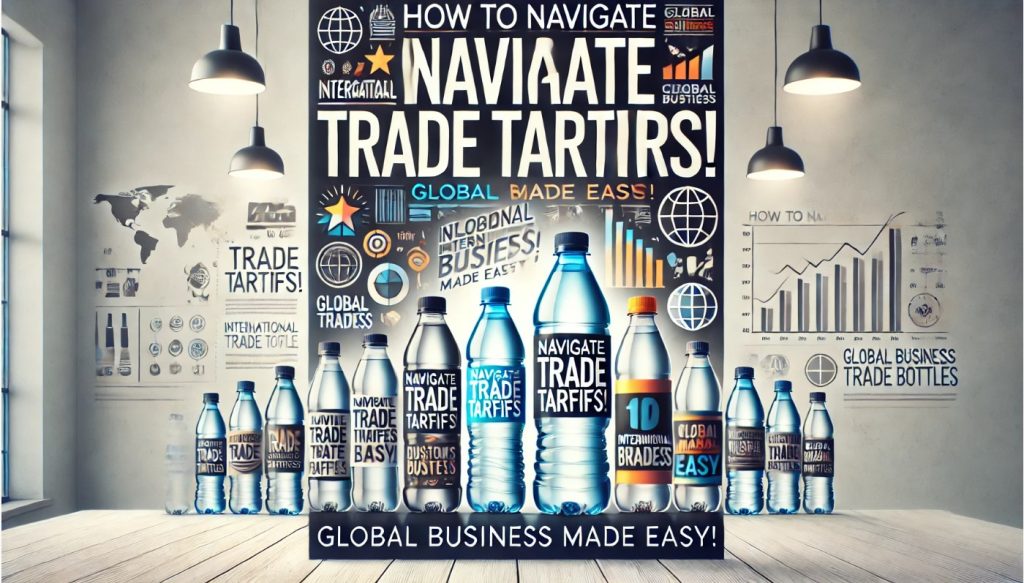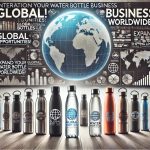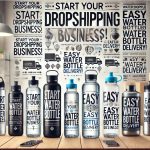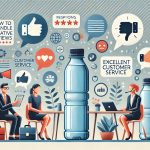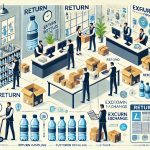The global market for water bottles has expanded significantly in recent years, driven by consumer demand for sustainable, reusable, and high-quality products. As businesses look to capitalize on this growth, they must navigate the complexities of international trade, including tariffs, duties, and customs regulations. Tariffs are taxes or duties imposed by governments on imported goods, and they can significantly affect the cost structure and profitability of water bottle manufacturers and retailers involved in cross-border trade.
For businesses engaged in the water bottle industry, understanding how tariffs work, how they are calculated, and how to mitigate their impact is critical. Tariffs can vary by country, product category, and trade agreements, and failure to account for these costs can lead to financial surprises or competitive disadvantages.
Understanding Tariffs and Their Impact on Water Bottles
What Are Tariffs?
A tariff is a tax imposed by a government on goods that are imported into a country. Tariffs are typically applied to protect domestic industries from foreign competition by making imported goods more expensive, thus encouraging consumers to buy locally produced items. They can also be used as tools in trade negotiations between countries.
For water bottles, tariffs are applied based on the product’s classification under the Harmonized System (HS), a globally standardized system for categorizing products traded internationally. The amount of the tariff depends on the country of origin, the type of product, and the trade agreements in place between the exporting and importing countries.
Tariffs are not the only form of trade barrier—non-tariff barriers such as quotas, licensing requirements, and customs procedures can also affect international trade. However, tariffs are often the most direct and measurable barrier that companies need to account for when shipping water bottles across borders.
How Tariffs Affect Water Bottle Manufacturers and Retailers
Tariffs directly impact the price competitiveness of water bottles in international markets. When tariffs are imposed, the cost of importing water bottles increases, which may lead manufacturers to raise prices or absorb the additional cost. For businesses that rely on global supply chains, understanding how tariffs affect their operations is critical for pricing strategies, cost management, and profit margins.
- Cost Impact: Water bottle manufacturers or distributors importing goods may face significantly higher costs due to tariffs, which can reduce profitability if not properly managed.
- Consumer Pricing: Increased tariffs often result in higher retail prices for consumers, potentially leading to reduced demand, especially in price-sensitive markets.
- Competitive Advantage: Companies that can efficiently manage tariffs and other import costs may gain a competitive edge, while those who struggle with rising import costs may lose market share to competitors.
For businesses in the water bottle industry, strategic planning and understanding tariff regulations are key to mitigating the financial impact of international trade and staying competitive.
Key Factors in Tariff Classification for Water Bottles
The Harmonized System (HS) Code
The Harmonized System (HS) is an internationally recognized system for classifying products in international trade. The HS system, developed by the World Customs Organization (WCO), assigns unique codes to products based on their composition, function, and materials. For water bottles, the HS code determines the tariff rates that apply to imports and exports between different countries.
Each product type within the water bottle category—whether it’s made of plastic, stainless steel, glass, or aluminum—has a specific HS code. This classification is essential for calculating tariffs and understanding the applicable duties and taxes.
For example, plastic water bottles typically fall under a different HS code than stainless steel or glass bottles, with each category potentially subject to different tariff rates. Accurate classification of water bottles ensures that businesses can comply with customs requirements and avoid penalties or delays at the border.
Country of Origin and Trade Agreements
The country of origin plays a significant role in determining the tariff rate on water bottles. Countries that produce water bottles may have different tariff obligations depending on where they are selling their goods. Trade agreements, such as Free Trade Agreements (FTAs), often reduce or eliminate tariffs on goods traded between signatory countries.
For example, under the North American Free Trade Agreement (NAFTA), water bottles manufactured in Mexico or Canada may be eligible for lower tariff rates when exported to the United States, compared to bottles made in countries outside of the agreement. Similarly, the European Union’s Customs Union allows for the free movement of goods between EU member states, reducing tariffs between them.
Tariff rates can be influenced by the presence of trade agreements, preferential tariff treatment, and rules of origin. Understanding these factors helps businesses identify opportunities to minimize import costs and optimize their global supply chain.
Product Specific Tariff Rates
Tariff rates for water bottles can vary not only by country but also by the material from which the bottle is made. For instance:
- Plastic Water Bottles: Water bottles made from plastic may attract a different tariff rate than those made from more durable materials like stainless steel or glass. Countries may impose higher tariffs on plastic bottles due to concerns over environmental impact and waste.
- Stainless Steel and Aluminum Water Bottles: Premium materials like stainless steel or aluminum may be classified under different tariff categories and may face lower tariffs due to their perceived higher value.
- Glass Bottles: Glass water bottles can also have distinct tariff rates, especially in regions where glass is seen as a more sustainable or premium alternative to plastic.
The classification of water bottles into specific categories based on their material composition and intended use is crucial for businesses when calculating potential tariffs. Working with customs experts and staying updated on tariff changes can help businesses avoid overpaying for imports and maintain competitive pricing.
How to Calculate Tariffs on Water Bottles
Tariff Calculation Methods
The calculation of tariffs for water bottles depends on various factors, including the HS code, country of origin, and the value of the goods. The most common methods of calculating tariffs are based on the value of the goods or the volume/weight of the product. The specific method used varies by country and trade agreement.
Ad Valorem Tariffs
An ad valorem tariff is based on the value of the imported goods. For water bottles, the tariff rate would be applied as a percentage of the invoice value. For example, if a shipment of water bottles is valued at $10,000 and the applicable tariff rate is 10%, the tariff would be $1,000.
Ad valorem tariffs are the most common method used by countries to impose import duties. They provide a simple way to calculate tariffs but may lead to higher costs for premium or luxury products, as the tariff is based on the total value.
Specific Tariffs
In some cases, tariffs are based on the volume or weight of the goods being imported. These are called specific tariffs, and they are commonly applied to bulk shipments or products that are less expensive on a per-unit basis. For water bottles, specific tariffs may be based on the number of bottles, their weight, or their size.
Specific tariffs are used when it is difficult to assess the value of goods accurately or when there is a desire to target low-cost imports. However, they can be less flexible than ad valorem tariffs and may increase the cost of shipping large quantities of water bottles.
Mixed Tariffs
Some countries use a combination of both ad valorem and specific tariffs, depending on the product. For example, a water bottle may be subject to both a base percentage value tariff and an additional cost based on weight or volume. This method is often used for products that require a more nuanced tariff calculation to reflect both their value and their physical characteristics.
Tariff Reductions and Exemptions
Under certain conditions, water bottle manufacturers and importers may be eligible for tariff reductions or exemptions. These reductions can be based on trade agreements, specific industries, or the nature of the product. For instance:
- Trade Agreements and Free Trade Zones: Trade agreements like the Comprehensive and Progressive Agreement for Trans-Pacific Partnership (CPTPP), EU Customs Union, and USMCA may reduce tariffs on water bottles between participating countries. These agreements often provide preferential rates for goods that meet specific rules of origin.
- Preferential Tariffs for Environmental Goods: Some countries offer lower tariffs on environmentally friendly products, such as reusable water bottles made from sustainable materials. For instance, water bottles made from recycled plastics or eco-friendly materials may qualify for lower tariffs in regions with strong sustainability initiatives.
It’s important for businesses to stay informed about tariff reductions and exemptions that may apply to their products. This can help lower the overall cost of importing water bottles and improve competitiveness in international markets.
Strategies for Minimizing Tariff Costs
Optimizing Supply Chain and Manufacturing Locations
One of the most effective strategies for minimizing tariffs is optimizing your supply chain and manufacturing processes. By strategically selecting countries or regions for production and sourcing, water bottle manufacturers can reduce tariff exposure.
Manufacturing in Low-Tariff Countries
Manufacturing water bottles in countries that offer favorable tariff rates can help minimize costs. For example, companies can set up production facilities in countries with preferential trade agreements or lower tariffs on goods like plastic or metal. By doing so, they can export water bottles to markets with lower import duties and take advantage of trade benefits.
Regional Sourcing and Production
Companies can also consider sourcing raw materials from countries with lower tariffs or trade agreements that provide preferential treatment. Regional supply chains, especially within economic blocs like the European Union, ASEAN, or MERCOSUR, can help businesses reduce tariffs and facilitate smoother trade.
Leveraging Free Trade Agreements (FTAs)
Free Trade Agreements (FTAs) can offer significant advantages for water bottle businesses by reducing or eliminating tariffs. FTAs are bilateral or multilateral agreements between countries designed to promote trade by removing trade barriers such as tariffs and quotas.
For example, under agreements like NAFTA (now replaced by the United States-Mexico-Canada Agreement, or USMCA), businesses that meet specific rules of origin requirements can export water bottles between the U.S., Mexico, and Canada with little or no tariff charges. Similarly, the CPTPP offers tariff reductions on goods traded between member countries, including water bottles.
To take full advantage of FTAs, businesses must ensure that their products meet the specific rules of origin, which typically require that a certain percentage of the product’s content be sourced from the member countries. Understanding the terms of these agreements can significantly reduce tariff costs.
Tariff Classification and Customization
Properly classifying water bottles and ensuring accurate documentation can help prevent overpayment of tariffs. Work with customs brokers or trade consultants to ensure that products are correctly classified under the appropriate HS code, as misclassification can lead to higher tariffs or customs delays.
Additionally, customizing packaging or product components to fit within lower tariff categories may help reduce costs. For example, a water bottle with a simple design or minimal components may fall under a more favorable tariff classification than a heavily customized or complex design.
Considering Tariff Engineering
Tariff engineering refers to the practice of designing or altering a product to qualify for a lower tariff rate. For water bottle manufacturers, this may involve modifying the materials, size, packaging, or components of a product to reduce its overall tariff burden. This strategy can help businesses reduce import duties without sacrificing product quality or performance.
While tariff engineering can be effective, it is essential to ensure that any changes made to reduce tariffs do not violate intellectual property laws or compromise product quality. Working with legal and compliance experts can ensure that tariff engineering efforts are both effective and compliant with regulations.
Navigating Customs Procedures and Documentation
Understanding Customs Clearance
In addition to tariffs, customs clearance is another critical component of international trade. Customs authorities in each country require specific documentation to assess the tariff classification and value of imported goods. Water bottle businesses must ensure that they have all necessary paperwork to avoid customs delays or penalties.
Key documents for customs clearance include:
- Commercial Invoice: A detailed invoice listing the goods being imported, including descriptions, quantities, and value.
- Bill of Lading: A document from the carrier confirming the shipment details.
- Certificate of Origin: A document verifying the country of origin for the water bottles, which is essential for determining eligibility for reduced tariffs under trade agreements.
- Packing List: A detailed list of the items being shipped, including weight, dimensions, and packaging details.
Ensuring that these documents are complete, accurate, and timely submitted can help streamline the customs process and avoid additional costs associated with delays or errors.
Working with Customs Brokers
Customs brokers are professionals who help businesses navigate the complexities of international trade by ensuring that goods comply with local customs laws and regulations. A customs broker can assist in tariff classification, documentation preparation, and the smooth clearance of shipments, ensuring that water bottles are imported without unnecessary delays or fines.
By partnering with an experienced customs broker, businesses can reduce the risk of costly mistakes and improve the efficiency of their international operations.
Conclusion
Navigating international trade tariffs on water bottles requires a comprehensive understanding of the tariff classification system, customs procedures, and trade agreements. By properly classifying products, leveraging trade agreements, and optimizing supply chains, water bottle businesses can minimize the impact of tariffs on their bottom line. Additionally, working with experts such as customs brokers and legal advisors can help ensure compliance with international trade regulations and improve the efficiency of cross-border operations. With careful planning and strategy, businesses can successfully manage tariff costs and remain competitive in the global water bottle market.

